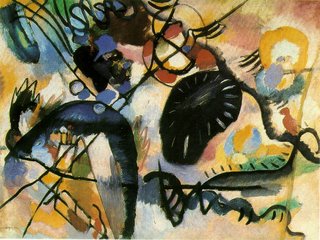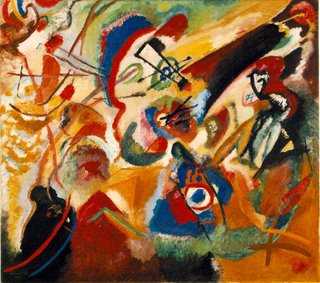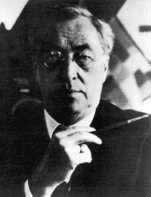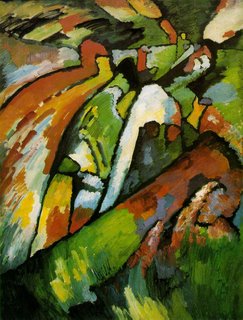Wassily Kandinsky Biography - 1866-1944
"Russian born Wassily Kandinsky is considered as the inventor and theorist of abstract painting in the 20th century. In 1910 Wassily Kandisnky had seen an Islamic art exhibition in Munich - a highly decorative art style that does not allow to show images of human beings. The same year Kandinsky created his first abstract painting.
Kandinsky's Early Years
Wassily Kandinsky was born in Moscow in 1866. He grew up in a bourgois, cultured family and learned to play the piano and the cello. In 1886 he began to study law and economics at the Moscow University. After passing his exams he started a teaching career at the Moscow Faculty of Law. He had many interests and apparently a great gift to teach himself different skills.
In 1895 Kandinsky saw an exhibition of French impressionists in Moscow with paintings of Monet and others. He was at first confused and would later described how upset he was about Monet's painting The haystack. He thought that the painter had no right to paint things in a way that made it difficult to recognize the subject.
In 1896, at the age of thirty, he decided to start a new career as an artist and went to Munich in Southern Germany. He enrolled at the Academy of Fine Arts for four years until 1900.
Der Blaue Reiter
The art of Kandinsky established itself rather fast from 1903 on through many exhibitions in Europe. In 1911 he formed together with other Expressionist painters the group Der Blaue Reiter.
Other members of the group were the Swiss painter Paul Klee, Franz Marc, August Macke, Gabriele Münter, Alexei von Jawlensky and Alfred Kubin. Kandinsky was the leading head of the group together with Franz Marc. His dominant position was not always to the delight of the other members.
Abstract Painting
Kandinsky became the theorist of abstract painting. In 1910 he created his first abstract work - a watercolor. In 1912 he published a book on the theory of abstraction.
The Blue Rider had only a short life due to the outbreak of World War I. In 1914 Kandinsky returned to Russia where he stayed until 1921. In 1922 he came back to Germany to teach and work at the Bauhaus in Dessau until 1933. During the years at the Bauhaus the artist had his most productive and prolific time.
When the German Nazis came to power in 1933, all modern art was considered as entartet (degenerated art) and the Bauhaus was closed in 1933. Kandinsky's works were removed from German museums and confiscated.
Emigration to Paris
The artist's next destination was Neuiily near Paris where he remained until his death in 1944. At the time of his emigration to France, he was a well-established artist in the United States. Salomon Guggenheim became one of his collectors.
Wassily Kandinsky continuously developed his style over the years but never made any abrupt changes as for instance Pablo Picasso did. His early paintings were expressive, colorful compositions but figural. The style reminds of Henri Matisse. From around 1910 the transition to abstract painting can be recognized. The figural elements were more and more reduced and finally they disappeared completely. Like a musician, he titled his art works impressions, compositions or improvisations. From around 1920 on, his style became rather geometrical.
The Lenbach Museum in Munich
If you should ever come to Munich, do not miss to visit the Lenbach Galerie or Städtische Galerie im Lenbachhaus as it is officially named. It has an incredible collection of Kandinsky paintings - mainly from his time with the Blue Rider. The paintings were donated to the museum by Gabriele Münter, another artist of the Blue Rider group. She was Kandinsky's companion until 1914 when he returned to Russia. During the Nazi rule, Gabriele Münter had stored a large number of his paintings in the basement of her house in the Bavarian countryside." http://www.artelino.com/articles/wassily_kandinsky.asp
There are some his painting:
 Black Spot I
Black Spot I Fragment 2 for Composition VII
Fragment 2 for Composition VIIIn my opinion, surely I do not understand the meaning and what he wants to show on his painting. Obviously, they are too abstraction. Cubism or Expressionism, I can see at least the objects on painting or what are drawing on painting. But the abstraction painting, I am absolutely get lost on the world of colors, shape and lines. I wish that I can understand the abstraction on his painting. What ever, may be some one can understand and feel comfortable with his art. I do not say that I dislike his painting; I just comment that I do not have enough knowledge to understand maybe. I think that, abstraction paintings are kinds of personal emotion or feeling of the authors. Author abstracts his ideas, thinking, and opinion on his art world. Why he chooses the abstraction is the way of presenting his art? I think there are must be some reasons.
In my own experience and opinion, I use abstraction when I do not want to show clearly my own feeling and purpose of my design. That helps me hiding my personal on my design to open the possibility of new feeling or communication to viewers. Some people can have same feeling or see likes what I do. However, there are still have many people have difference feeling as their own perspective. It voids the situation that author tries to show his ideas and wants everyone think the same way. Surely, It is impossible. For example, some one draws a complete chair. Some one can look at it and says: " Oh ! I like this table!", because at his home, he uses chair as table. The author surely never gets angry and tries to say that:" It is a chair! Don’t you see!". Abstraction can solve those problems. Viewers can have their own feeling. It is the key to open the new theorem to postmodern art later. Don’t you think so? There is just my own bias opinion. I know you also have your own thinking. If you know something, I am surely happy to listen to.



0 Comments:
Post a Comment
<< Home